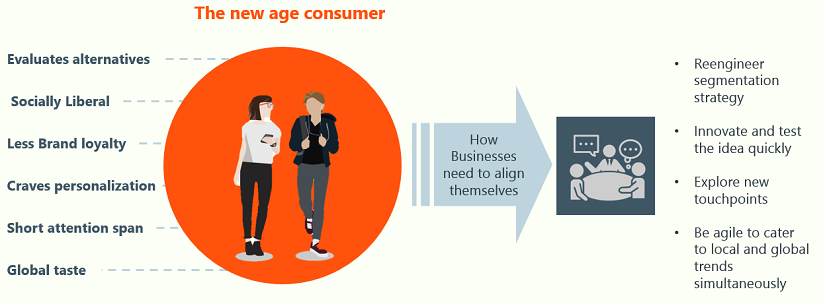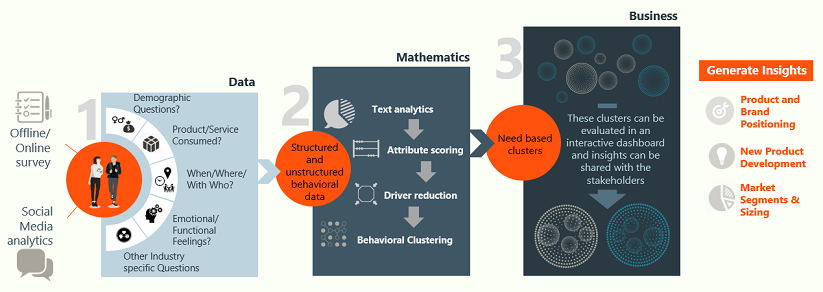Rethinking traditional consumer segmentation
The good old concept of customer segmentation, targeting and positioning framework, has stood the test of time and have helped marketers take strategic business decisions. These business leaders have routinely used demographic analysis to help craft a brand’s message, positioning, and marketing. By grouping consumers mainly by age, geography, ethnicity, gender, income and family status, marketers have been able to draw conclusions about that group’s shared interests and consumption behaviors.
But today, do new age consumers belonging to the same target segment, behave alike? Probably not.
By confining the consumers within the demographics conventions, we have instinctively assumed that everyone within the same group has similar needs. But in reality, consumers today construct their personality based on their interests, which in turn drives their behavior and consumption patterns. For example, according to trendwatching.com, in the UK, women now account for the majority of video game players, and there are more gamers aged over 44 years than under 18 years. Surprising, but true!
How should the marketers think differently?
To re-engineer their strategy, marketers need to understand why these new age consumers are not behaving as they should.
Listed below are some of the most common reasons:
• Access to ubiquitous information through technological advancements
• Diverse interest sets because of multicultural societies
• Ever demanding need for personalization
These factors have led to an unpredictable interest choices of the new age consumers. For example, there is a 40% overlap between the list of the 1,000 favorite artists for 60-year-olds and the 1,000 favorite artists for 13-year-olds, which points that demographic boundaries for music interests are getting blurred in today’s scenario.
Who are these new age consumer and how should we target them?

How can a data driven approach, yield better results?
To make the segmentation strategy more effective and precise, marketers should understand the consumer’s needs and interests in a better way, and reposition their product around these needs. But in this dynamic market and fluid society, identifying these context-based segments can be a challenging task. This is where analytics comes in to the picture. Using a data-driven approach, marketers can understand what drives consumers within a particular need cluster and how to appeal to this segment group.
At LatentView, we help our clients take a data-driven approach to form a 360-degree view of their consumer. Our proprietary offering – APT framework, merges data and mathematics to identify the most appropriate distinct set of characteristics around which a product should be positioned. These characteristics are mutually exclusive sets of needs and each of these sets comprises different attributes that can help us understand what are the top needs and their associated drivers.
How it works?
To arrive at insights, we gather structured and unstructured data from surveys and social media. By leveraging social media along with surveys, we can quickly explore topics and discover many patterns, trends, and insights, without predetermining what we are looking for. This data is processed using advanced analytical techniques like lexical processing, attribute scoring, driver reduction and behavioral clustering to provide the list of needs, their context and relevant target segments. Some of the attributes that can be associated with the needs are:
• Related demographic
• Occasions and frequency of use
• Companions
• Time of the day
• Emotional drivers
• Functional drivers
We have observed that if we look at each of these sets holistically, we can reposition out products to align to these needs, thereby improving marketing effectiveness.
The journey towards insights

We propose a three-phase process to arrive at these deep-dive insights:
Phase 1 – Gather relevant data: When it comes to unlocking consumer behavior, the ideal approach is to use an amalgamation of both structured (e.g. survey) and unstructured (e.g. social media) data to understand drivers and associated attributes of consumption. It is recommended to conduct surveys over a large sample size which is representative of the entire population set.
Phase 2 – Do the math: Using advanced analytics techniques, process the unstructured and structured data to arrive at clusters which are mutually exclusive in terms of the needs they represent. These clusters can then be sorted based on the significance and size.
Phase 3 – Use business lens to evaluate: Finally, these clusters are combined with business acumen to validate their relevance in terms of business requirements. In our experience, we have seen organizations merging several clusters which serve similar needs to develop their strategies around these clusters.
To summarize, adopting a needs-driven approach to segment consumers can achieve superior results than just demographic based demarcations. It has been observed with many of our clients that, applying advanced analytics techniques on both structured and unstructured data yields more accurate results.
The concepts discussed here are few of the common targeting and segmentation processes involving analytics. To know more, email: marketing@latentview.com.



